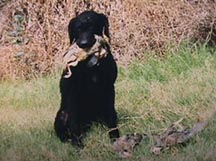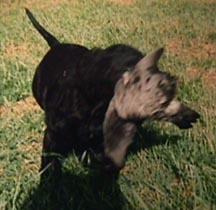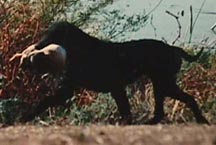

Field Training - part one, puppies
Field training Curly Coated Retrievers is no different than field training any other retriever breed - successful training of most dogs of any breed requires that the trainer be flexible and willing to modify their training program to fit the dog. Most professional trainers have a rigid program that the dog must fit into or be washed out - most pros are under pressure to produce quick results or the client will take the dog somewhere else. However, this means that many dogs of all breeds are washed out simply because the pro can’t or won’t deviate from a “proven formula”, even tho this “proven formula” generally only works well with dogs that were bred with it in mind!
People inexperienced in field training will state that “Curlies cannot be trained like Labs”, but this just isn’t true - it is generally not a good idea to train a Curly the way one would train a trial bred Lab to run field trials, but it also is generally not a good idea to train any non-field trial bred dog that way! Show bred, hunt bred, backyard bred Labs wash out of pros kennels all the time - even trial bred ones do!

What follows is what I use as a base for my training "program" (such as it is...). There is no one right way to train all dogs - it is up to the trainer to know when to try something new, or to keep plugging away because the dog just needs a few more repetitions. So, like life, my “program” can lead in lots of different directions, depending on the dog!
The best way to start is to get a puppy from parents that have been proven in the field; even better would be to watch the parents work in the field. However, since most Curly pups are purchased sight unseen, these buyers won’t get a chance to watch the parents work. Field titles are a good indication of whether a dog has drive/desire, tho it should be a title higher than a WC. Yes, there are many good working Curlies out there with “just” a WC or even no titles but for the buyer who must purchase their pup without the opportunity to see at least one parent work, field titles are the best indicator of unbiased opinon on the dog’s abilities. Ask questions about the parents - how well do they mark, was it difficult to get them steady (if they are), were they natural carriers prior to force fetch (if it was done), were they easy to train or was it a battle, etc.. Even MH titled dogs can be more the product of training than genetics, so try to read between the lines of whatever titles the parents may have and what the proud owner may say.
best indicator of unbiased opinon on the dog’s abilities. Ask questions about the parents - how well do they mark, was it difficult to get them steady (if they are), were they natural carriers prior to force fetch (if it was done), were they easy to train or was it a battle, etc.. Even MH titled dogs can be more the product of training than genetics, so try to read between the lines of whatever titles the parents may have and what the proud owner may say.
Another point - there are those that state that since Curlies are not split into show and field lines like Labs and Goldens are, one can get a field prospect Curly from any litter, even one with a show bred pedigree for several generations. This used to be somewhat true but, at least in the US, it no longer is and every year the odds of getting a good working field pup from a show bred Curly litter get smaller. Just as working desire and ability has been bred out of many lines of show bred Labs and Goldens, so it goes with Curly breeders who are not concerned with field ability when making breeding decisions. It is certainly possible to field train a mediocre field dog and have it earn a lower stake field title or serve as a decent hunting companion, but it isn’t easy and a little study should keep a buyer from ending up with a less than driven blockhead.
has been bred out of many lines of show bred Labs and Goldens, so it goes with Curly breeders who are not concerned with field ability when making breeding decisions. It is certainly possible to field train a mediocre field dog and have it earn a lower stake field title or serve as a decent hunting companion, but it isn’t easy and a little study should keep a buyer from ending up with a less than driven blockhead.
OK, now we have the new critter in the house, 7-8 weeks old. Take a mans tube sock and stuff other socks into it until it is fairly firm but not too big - it should be about half the size of a regular bumper. Then tie off the end and either tuck it in or cut it off, so that the pup learns from the very beginning to carry by the “body” rather than trailing end. Find a hall in the house where you can block one end and sit at the other, tease the pup with the sock bumper by waving it in front of Pup’s face and when Pup is interested, throw the bumper a short distance down the hall. Don’t throw more than a foot or so as baby pups can’t really see that well and they are really easily distracted! Ideally the pup will bounce out to the bumper, snatch it up and come running back, but these sorts of pups are not the majority. Some will need to be teased quite a bit, some will need two or three throws (each should be shortened) before they get the idea, some will need to wait a week or two before they get it together.
(This is another reason why it is wise to purchase a field pup from someone that does field work, as those breeders will have a much better idea which pups actually have promise of being good workers and those breeders will have already introduced the pups to things to fetch, maybe even birds.)
Assuming that Pup is fetching the sock bumper, throw it about three times a session with probably no more than three sessions a day. Baby pups tire and distract easily, so it is far better to stop when Pup still really wants that bumper than to push it too far, even if its only when Pup begins to show a little less interest. The goal is to have Pup always totally excited, so quit while interest level is at its highest, not when it starts to go down, even if this means only one throw.
After the last throw and retrieve, mildly tease the pup with the sock bumper without letting him have it before you put it up so the session ends with him really really
wanting that thing!
Pup always totally excited, so quit while interest level is at its highest, not when it starts to go down, even if this means only one throw.
After the last throw and retrieve, mildly tease the pup with the sock bumper without letting him have it before you put it up so the session ends with him really really
wanting that thing!
Get into the habit of using a release word, such as Pup's name or Fetch when you throw the sock bumper, whether you are holding the pup or throwing while Pup is loose. If Pup gets used to hearing this word every time he leaves to retrieve from the very beginning, it may also help him learn to be steady later in life since some pups actually learn to feel funny if they leave to retrieve without hearing the "magic word"!
Mildly work on steady and delivery to hand - habits set now will stay with a dog for a lifetime. Work on steady by holding the pup as you throw the sock bumper, letting him go as it hits the floor. Encourage delivery by allowing the pup to hold the sock while you stroke and pet him and tell him what a wonderful puppy he is before you take it. If the pup wants to hold on even when you try to take it, gently open his mouth by opening his jaws at the hinge without pinching his lips; the point at this age is to make everything fun and try to shape behaviors without any negative stress.
Also work on puppy obedience - learning sit, down, come and walk nice on a lead in very short, upbeat sessions with lots of treats and praise. The point at this time is to teach the puppy a general concept of what these words mean as a foundation for later, but not actual obedience. On the other hand, don’t use any obedience commands in a situation where the pup could disobey without your being able to stop it, ie - don’t call the pup using whatever word you will later use for requiring absolute obedience, when the pup is loose in the backyard and not interested in coming inside.
As soon as possible, take Pup swimming - the earlier a pup is introduced to water, the easier it is for it to learn to swim. Baby pups will usually just start swimming right off, whereas older pups and adults seem to think they can climb up on the top of the water and walk on it, flailing their front legs about and doing alot of splashing. Start water work when the water is reasonably warm, find a pond with little or no current and wade right in. About half the pups will follow and basically just start swimming, others will need to be encouraged into this weird wet stuff by splashing around in wading water (for the pup) and then easing further and further out until you “accidentally” end up in swimming water. Another way to do it is if you have an adult dog that swims well and is reasonably calm (so it won’t mow the pup over or something!), throw a bumper for the adult out to what would be just barely swimming water for the pup and many pups will just follow the adult dog out.
Very occasionally is the pup that simply won’t go into the water of its own choice, or won’t go beyond the wading depth no matter what the temptation. After trying everything you can think of to tempt the pup to try swimming, pick it up, wade out to barely swimming water depth for the pup, hold it by the chin and tail root and gently lower into the water pointing towards the shore, letting go as the pup starts to paddle. And paddle it will - there seems to be some kind of instinct in baby pups that tells them how to swim. Repeat 2-3 times, slightly further from shore each time so the pup has to swim 3 strokes, 4 strokes, etc before it gets to wading water. If this sort of introduction is done gently, Pup should be willing to enter swimming water on its own after a few repetitions.
Take Pup out on long walks thru all kinds of cover - tall grass, scrubby bushes, marsh, whatever you can find so he gets used to all kinds of cover and also gets used to changes in cover. Attend hunt tests or picnic tests with Pup starting out by sitting at least 200 yards from any guns and introduce him to the sound of gunfire. Move closer as the pup shows no fear or stress from the gunfire - if you have any doubt, stay where you are for awhile longer! Some pups start out a bit sensitive to gunfire, but they aren’t really gunshy, they just need to be introduced to it a bit slower. Snag a dead pigeon and play with Pup with it, let him sniff and maybe try to drag a duck or pheasant around.
by sitting at least 200 yards from any guns and introduce him to the sound of gunfire. Move closer as the pup shows no fear or stress from the gunfire - if you have any doubt, stay where you are for awhile longer! Some pups start out a bit sensitive to gunfire, but they aren’t really gunshy, they just need to be introduced to it a bit slower. Snag a dead pigeon and play with Pup with it, let him sniff and maybe try to drag a duck or pheasant around.
Continue giving Pup as many good experiences as possible - as he gets comfortable (and not too distracted) in water and afield, throw his sock bumper a short distance in cover or clear where it can easily be seen. Slowly lengthen the throws, slowly throw in higher cover, only doing so when you are sure that Pup is comfortable at the previous distance or previous cover. Always try to make each throw at least a 90% chance for success at this stage of Pup’s life.